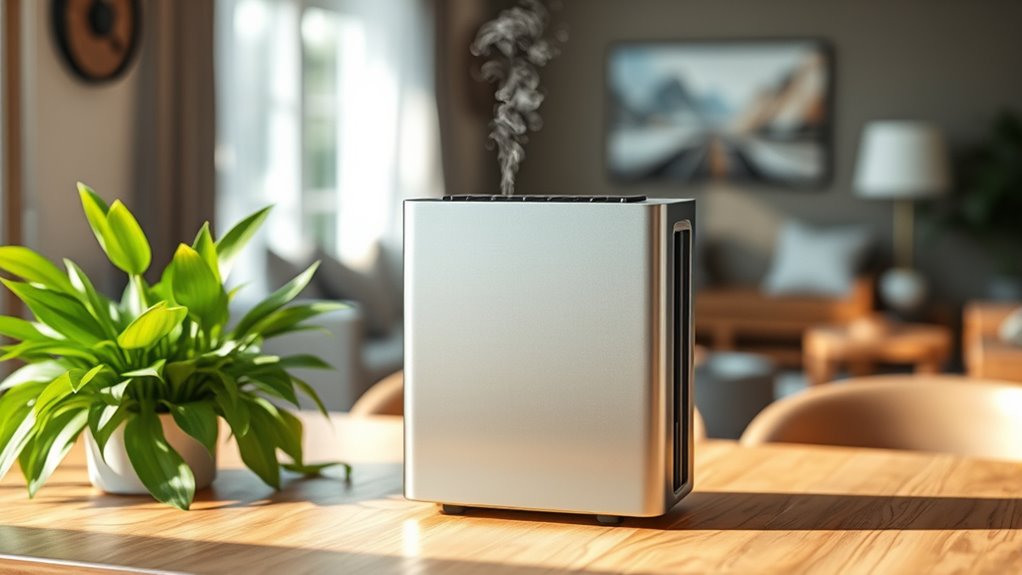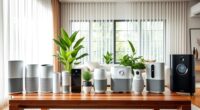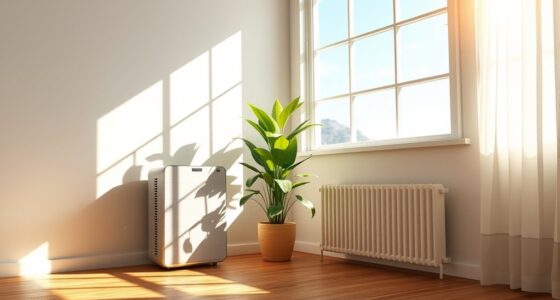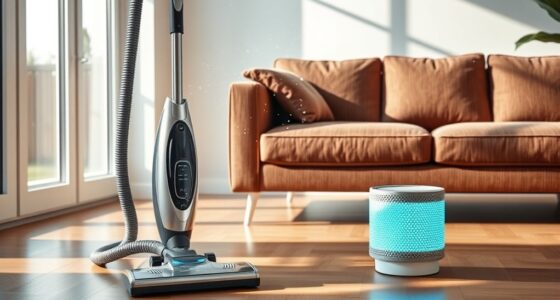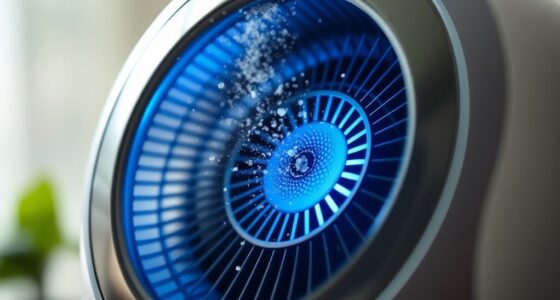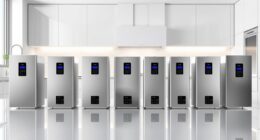Air purifiers work by drawing in indoor air, filtering it through various filters, typically including HEPA filters that capture 99.97% of tiny particles like dust and pollen. There are portable units for specific rooms and whole-house systems for larger spaces. They improve air quality, reduce allergens, and can benefit respiratory health. Regular maintenance, such as cleaning filters, is key to their performance. Stick around to discover more on choosing the right air purifier for your needs.
Key Takeaways
- Air purifiers draw in indoor air, filtering it through various filters, primarily HEPA, to capture particles like dust and pollen.
- HEPA filters trap at least 99.97% of particles as small as 0.3 microns, significantly improving indoor air quality.
- Activated carbon filters remove gases and odors by adsorbing VOCs, complementing the filtration capabilities of HEPA filters.
- Regular maintenance, including filter replacement and cleaning, is crucial for optimal performance and effectiveness in reducing airborne pollutants.
- The Clean Air Delivery Rate (CADR) measures an air purifier’s efficiency, and a higher CADR ensures better air quality in the space.
How Air Purifiers Function
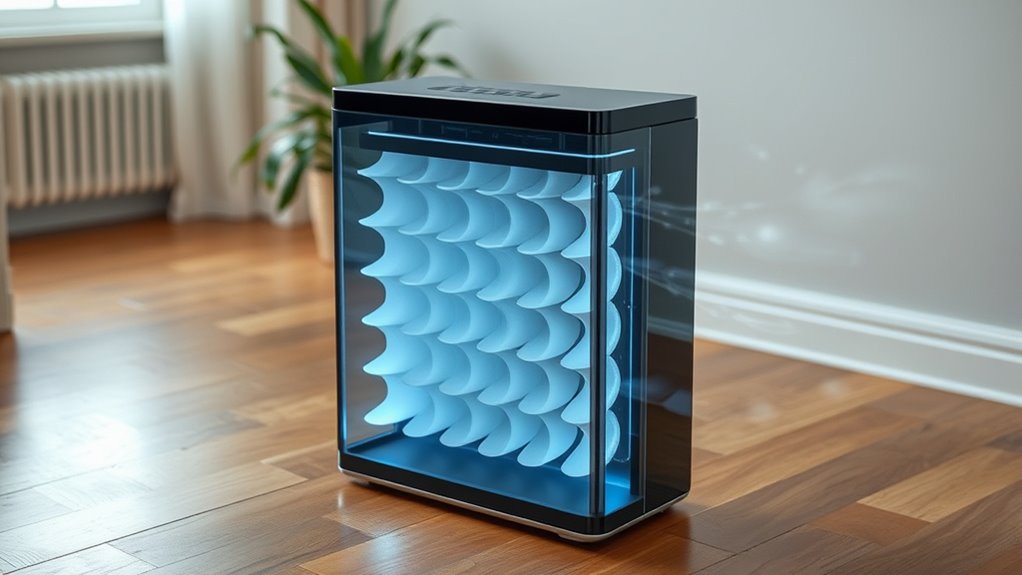
Air purifiers function by efficiently removing airborne particles and pollutants, making your indoor environment cleaner and healthier.
They operate by drawing in indoor air using a fan, filtering it through various types of filters, and circulating clean air back into your space. Most air purifiers utilize HEPA filters, which capture at least 99.97% of particles like dust, pollen, and pet dander. Regular maintenance, including cleaning filters, is essential to ensure their optimal performance. Studies indicate that air purifiers can also lead to improved respiratory health and alleviate symptoms of asthma and allergies. The presence of home security systems can further enhance the overall safety of your indoor environment. Some models also incorporate activated carbon filters that absorb gases and odors, improving indoor air quality, while others may feature UV-C light technology to kill bacteria and viruses. The Clean Air Delivery Rate (CADR) measures how effectively an air purifier can filter specific pollutants. Additionally, many air purifiers feature smart technology that enhances user convenience through connectivity and automation.
While air purifiers greatly reduce indoor air pollution, they work best when combined with proper ventilation and regular cleaning practices for ideal results.
Types of Air Purifiers

When choosing an air purifier, you’ll find two main types: portable units for single rooms and whole-house systems that work with your HVAC. Each type features different filters, like HEPA for trapping tiny particles and activated carbon for eliminating odors. Regular filter replacement is crucial for maintaining optimal performance and ensuring effective air purification. To achieve the best results, consider models with HEPA filtration technology, as they effectively capture allergens and pollutants. Additionally, many air purifiers now offer smart home integration to enhance convenience and monitoring capabilities. Some models also include features like anti-allergen technology for improved allergen control. Maintaining air quality indicators can also help you keep track of when maintenance is needed.
Portable vs. Whole-House Systems
Choosing between portable and whole-house air purifiers can greatly impact your indoor air quality.
Portable air cleaners are perfect for targeting specific indoor spaces, offering air quality improvement where you need it most. They often use HEPA filters, capturing 99.5% of particles 3 microns or smaller, with their effectiveness influenced by the Clean Air Delivery Rate (CADR). Additionally, many portable units, such as the AROEVE Air Purifier, are designed to eliminate allergens and odors effectively. These units can also feature advanced cleaning functions, ensuring enhanced hygiene in your immediate environment. Furthermore, their portability allows for flexible placement in various rooms based on your needs. Regular maintenance, including filter replacement, is crucial to maintaining optimal performance and air quality. Implementing data-driven decision-making can help you select the best air purifier for your specific needs.
For larger areas, whole-house air purifiers integrate with your HVAC system, providing centralized air filtration. They can filter gases and particulates using a combination of HEPA and activated carbon filters, ensuring consistent air quality throughout your home.
While portable units are easy to set up, whole-house systems may require more installation and maintenance, but they cover larger spaces more effectively.
Filter Types and Functions
While various filter types can greatly enhance your indoor air quality, understanding their functions is essential for making an informed choice.
HEPA filters are a popular option, effectively trapping at least 99.5% of particles, including dust, pollen, and smoke. Regular maintenance of HEPA filter systems ensures optimal performance and air quality. Additionally, maintaining color accuracy in the environment can enhance the perceived quality of the air being circulated. Incorporating hydration techniques into your routine can further support skin health, especially in environments with purified air.
Activated carbon filters excel at removing gases and odors by adsorbing volatile organic compounds (VOCs).
Some air purifiers include pre-filters that catch larger particles, extending the life of the HEPA filter and improving overall efficiency.
Be cautious of ozone-generating air cleaners, as they create harmful lung irritants without effectively filtering particulate matter or gases.
The Clean Air Delivery Rate (CADR) measures an air purifier’s effectiveness in reducing indoor air contaminants, with higher ratings indicating better performance.
Additionally, understanding venting requirements is crucial in ensuring that air purifiers function efficiently without compromising safety.
Benefits of Using Air Purifiers
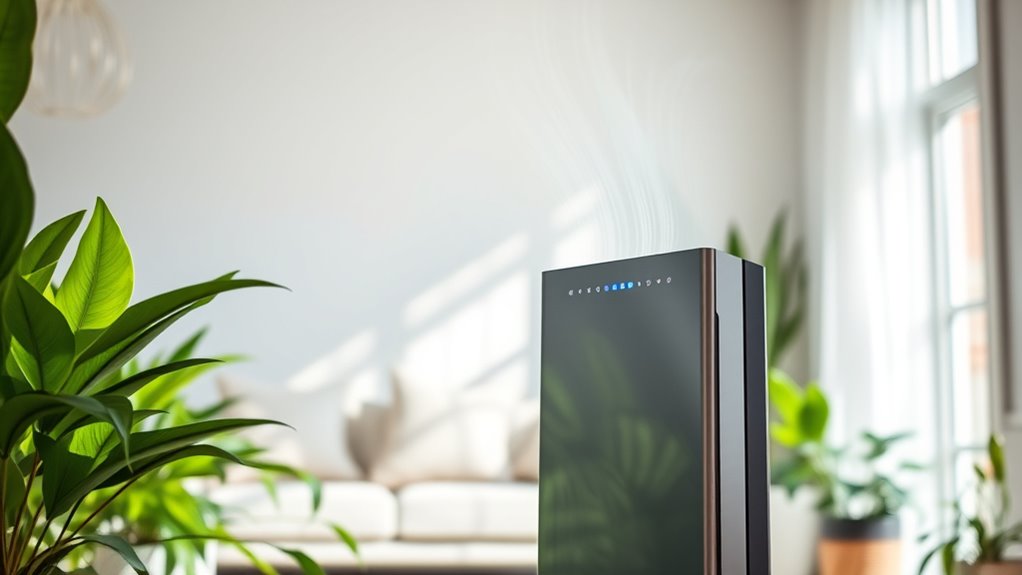
Using an air purifier can greatly enhance your indoor environment by reducing allergens like dust and pollen. You’ll likely notice improved respiratory health and overall air quality, making your space feel fresher and more comfortable. Plus, cleaner air can lead to better sleep, especially if you’re sensitive to nighttime irritants. Additionally, incorporating solar-powered solutions can further enhance your home’s environment by promoting energy efficiency and reducing your carbon footprint. Regular filter cleaning of your air purifier is essential for maintaining its effectiveness and ensuring optimal air quality.
Allergen Reduction Benefits
Air purifiers offer considerable benefits for reducing allergens in your home, especially if you or someone in your family suffers from allergies.
Equipped with HEPA filters, these devices capture at least 99.97% of airborne particles as small as 0.3 microns, effectively filtering out dust, pet dander, and pollen.
By considerably lowering indoor air pollutants, air purifiers can help alleviate allergy symptoms for sensitive individuals. They also minimize the presence of mold spores, contributing to better air quality.
Regular use of air purifiers can lead to a reduction in respiratory symptoms, making your living space healthier.
With over 100 million people in the U.S. experiencing allergy symptoms annually, air purifiers are a valuable tool in managing indoor allergens.
Improved Respiratory Health
When you invest in an air purifier, you’re taking a significant step toward improving your respiratory health.
Air purifiers equipped with HEPA filters capture at least 99.97% of airborne particles, including allergens like dust and pollen. This can lead to fewer respiratory symptoms, especially for those with asthma.
By lowering indoor PM 2.5 concentrations by 50% or more, air purifiers help minimize exposure to harmful indoor pollutants and volatile organic compounds (VOCs).
With a high clean air delivery rate, these devices reduce irritants and allergens, making the air you breathe cleaner and safer.
Regular use also aids in decreasing the transmission of airborne viruses, contributing to improved respiratory health in your home.
Enhanced Indoor Air Quality
Investing in an air purifier not only boosts your respiratory health but also greatly enhances indoor air quality.
Air purifiers effectively reduce allergens like dust, pollen, and pet dander, helping alleviate allergy symptoms for millions. With HEPA filters, they capture at least 99.97% of particles as small as 0.3 microns, targeting harmful aerosols that can worsen respiratory issues.
Studies show they can lower particulate matter (PM2.5) concentrations by 50% or more, markedly improving overall air quality. Additionally, air purifiers equipped with activated carbon filters tackle volatile organic compounds (VOCs) and odors, creating a healthier living space.
When combined with proper cleaning supplies and good ventilation, the indoor air quality can be 2-5 times less polluted than outdoors.
Key Features to Consider
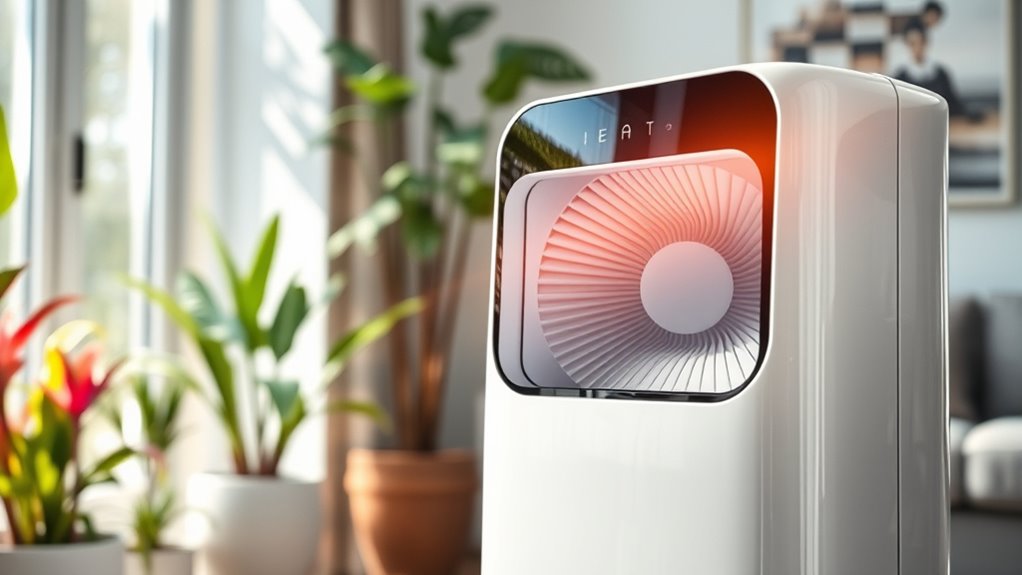
Choosing the right air purifier can greatly enhance your indoor air quality, so it’s vital to focus on several key features. Start by checking the Clean Air Delivery Rate (CADR); it should be at least two-thirds of your room’s area for effective filtration. HEPA filters are essential, capturing 99.97% of particles 0.3 microns or larger, guaranteeing allergens and pollutants are removed efficiently. Consider noise levels, especially if you need a quiet mode for nighttime. Don’t forget to evaluate filter replacement frequency and costs, as this impacts long-term expenses. Finally, smart connectivity can provide remote control and scheduling, making air management easier.
| Feature | Importance |
|---|---|
| CADR | Filters air effectively based on room size |
| HEPA Filters | Removes 99.97% of allergens and pollutants |
| Noise Levels | Guarantees comfort during sleep |
| Filter Replacement | Impacts long-term maintenance costs |
| Smart Connectivity | Enhances user convenience |
Common Misconceptions About Air Purifiers
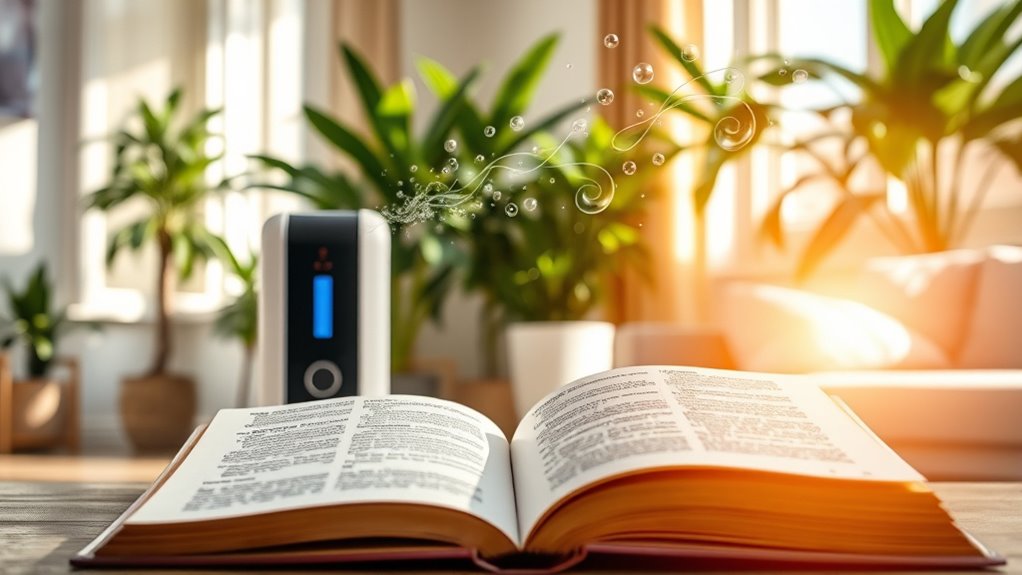
What do you really know about air purifiers? Many misconceptions surround their effectiveness.
For instance, you might think they eliminate all indoor air pollutants, but no purifier can achieve 100% removal.
Also, while HEPA filters capture particulate matter, they don’t filter out volatile organic compounds (VOCs)—that’s where activated carbon filters come in.
Some believe all air purifiers produce harmful ozone, but many certified models are safe for indoor use.
It’s also a myth that larger units are always better; focus on the Clean Air Delivery Rate (CADR) instead.
Finally, don’t assume air purifiers eliminate the need for regular cleaning—proper filter replacement and maintaining a clean environment are essential for peak performance.
Maintenance and Care for Air Purifiers
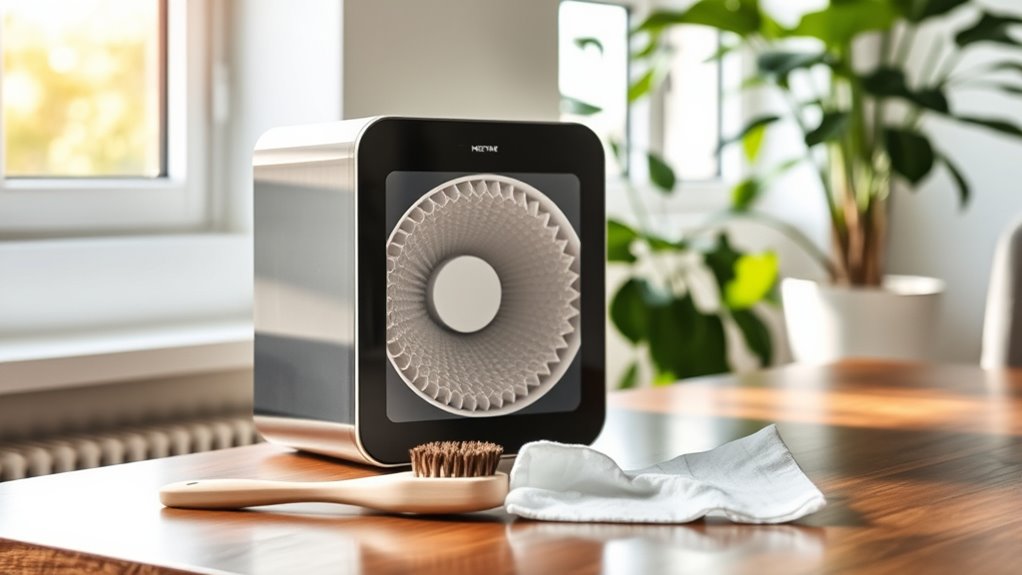
To keep your air purifier functioning at its best, regular maintenance is crucial.
Start by replacing HEPA filters and activated carbon filters every 6-12 months, as recommended by the manufacturer, to maintain peak air purification efficiency.
Replace HEPA and activated carbon filters every 6-12 months to ensure optimal air purification performance.
Clean the pre-filters every 1-3 months to remove dust and guarantee proper airflow, since accumulated dirt can hinder performance.
Monitor the Clean Air Delivery Rate (CADR) to verify it suits your room size, helping you assess its effectiveness against airborne pollutants.
Place the air purifier in a well-ventilated area and avoid obstructions like walls or furniture.
Finally, regularly check the fan and sensor functionality to prevent operational issues, confirming your air purifier continues to operate efficiently.
Frequently Asked Questions
How Does an Air Purifier Work Step by Step?
An air purifier‘s like having a superhero for your indoor air!
First, it pulls in room air using a fan.
Next, that air passes through filters, with HEPA filters capturing 99.97% of tiny particles like dust and pollen.
Some models also use activated carbon to absorb unwanted odors.
Finally, the cleaner air gets released back into the room, ensuring you breathe fresh and healthy air.
Just remember to replace the filters regularly for peak performance!
Are You Supposed to Leave an Air Purifier on All Night?
Yes, you should leave an air purifier on all night.
Doing so helps improve your indoor air quality by filtering out allergens and pollutants while you sleep. Most air purifiers run quietly, so they won’t disturb your rest.
By keeping it on, you’re continuously circulating and cleaning the air, which can reduce allergy symptoms and asthma triggers.
Just remember to replace the filters regularly to maintain its efficiency throughout the night.
Is There a Downside to Air Purifiers?
Did you know that air purifiers can reduce airborne particles by up to 99%?
However, there are downsides to take into account. They don’t eliminate all pollutants, especially gases and VOCs, and some models produce ozone, which can irritate your lungs.
Plus, if you don’t maintain them properly, their performance drops considerably.
Finally, noise levels can disrupt your sleep or concentration, especially if the purifier lacks a quiet mode.
How Many Hours a Day Should You Run an Air Purifier?
You should run your air purifier for at least 12 to 24 hours a day, especially if you’re in an area with high allergens or pollutants.
Continuous operation helps maintain cleaner air and greatly reduces airborne contaminants. Most purifiers can filter the air multiple times per hour, ensuring effectiveness.
If noise bothers you, look for a model with a quiet mode to keep it running while you sleep, without disruption.
Conclusion
Incorporating an air purifier into your home is like bringing a refreshing gust of mountain air indoors. Just as trees filter pollutants, air purifiers cleanse your space, making it healthier and more inviting. With their various types and features, finding the right one for your needs isn’t just smart—it’s essential. So, take a step towards a cleaner atmosphere, and enjoy the peace of mind that comes with knowing you’re breathing easier every day.
